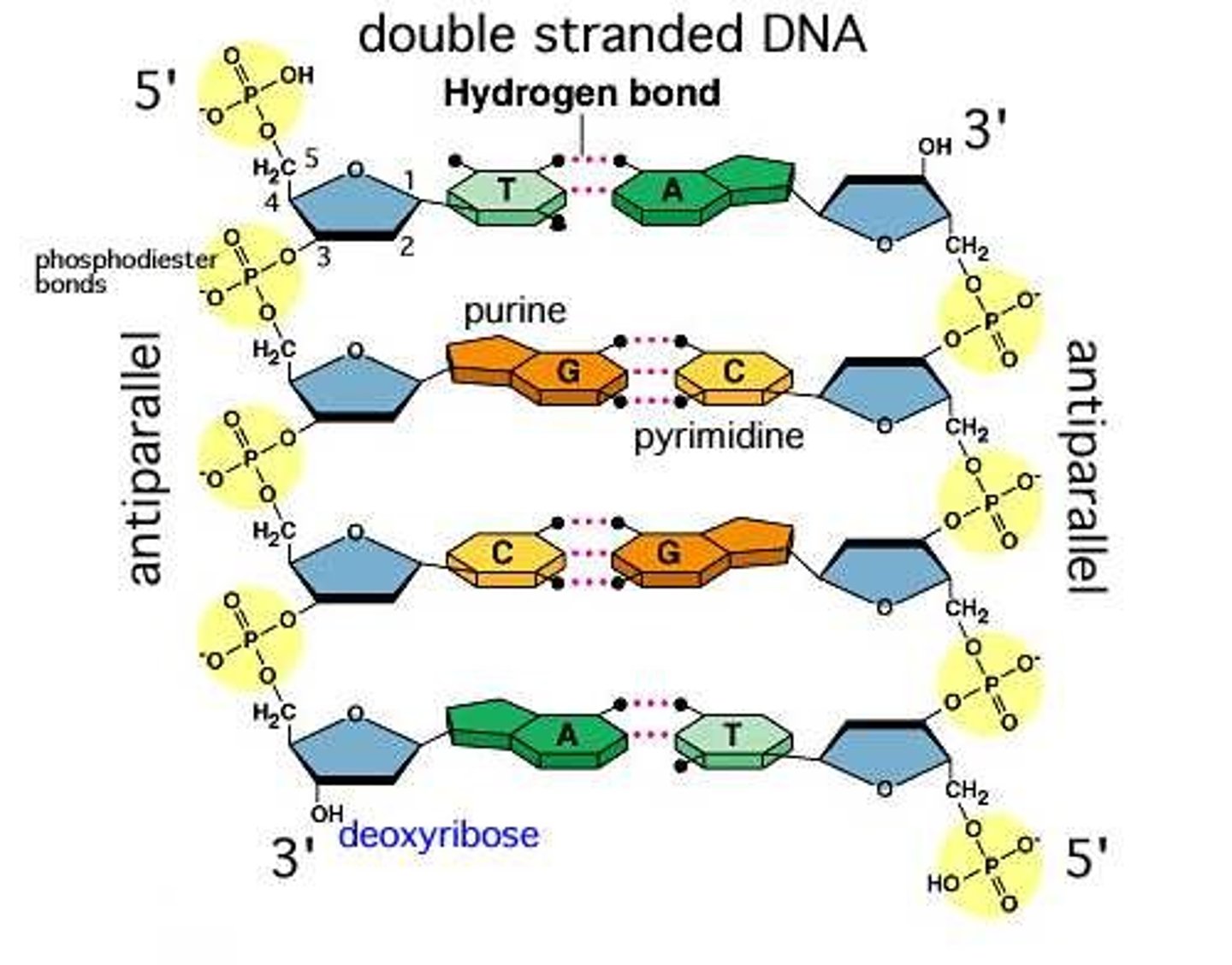IB BIO EOT
1/67
There's no tags or description
Looks like no tags are added yet.
Name | Mastery | Learn | Test | Matching | Spaced |
|---|
No study sessions yet.
68 Terms
Compare and contrast DNA and RNA
BOTH DNA and RNA are types of nucleic acid
DNA is double-stranded but RNA is usually single-stranded
the sugar in DNA nucleotides is deoxyribose BUT in RNA it's ribose
thymine in DNA BUT uracil in RNA
Describe how genomes can be used to analyse evolutionary relationships.
Genomes can be used to analyze evolutionary relationships by comparing the DNA sequences of different organisms
- Through molecular clocks which can be used to estimate when different clades diverged from each other
- The DNA from a genome can also be used to construct cladograms
- the genetic code of a genome can be used as evidence of a universal common ancestor
Outline the structure of a DNA molecule.
- DNA is double-stranded
- composed of (DNA) nucleotides
- double helix
- sugar-phosphate backbone
- hydrogen bonds between complementary base pairs
- adenine pairs with thymine OR cytosine pairs with guanine
Outline the effects of water molecule polarity
The polarity of water molecules, due to their uneven distribution of charge, leads to the formation of hydrogen bonds between water molecules , which leads to:
- solubility
- surface tension
- high specific heat capacity
-adhesion as a result of polarity
Explain the origins and retention of water on Earth and its importance in the search for extraterrestrial life.
- origin: asteroids as the primary source of water on Earth
- retention of water on Earth as a result of gravity
- goldilocks zone as the area around a star which could support liquid water (where earth is)
- all these are important when looking for extrerrestial life as water is a vital component in the evolution of life
Describe the properties of water and their consequences for living organisms.
- cohesion as the attraction of water molecules to other water molecules
- surface tension as a result of cohesion between water molecules is utilised by organisms living on the surface of water
- adhesion as the attraction of water to other substances
- capillary action as a result of adhesion
- a wide variety of hydrophilic molecules can dissolve in water
- water as a medium for enzyme catalysis
- density of water supports allows organisms float
- high specific heat capacity makes water an effective coolant ✓
(i) State which type of nucleic acid the nucleotides pictured are part of. Justify your answer.
(ii) State the type of bond indicated by 'the dotted lines"
DNA
- thymine present
- hydrogen bond
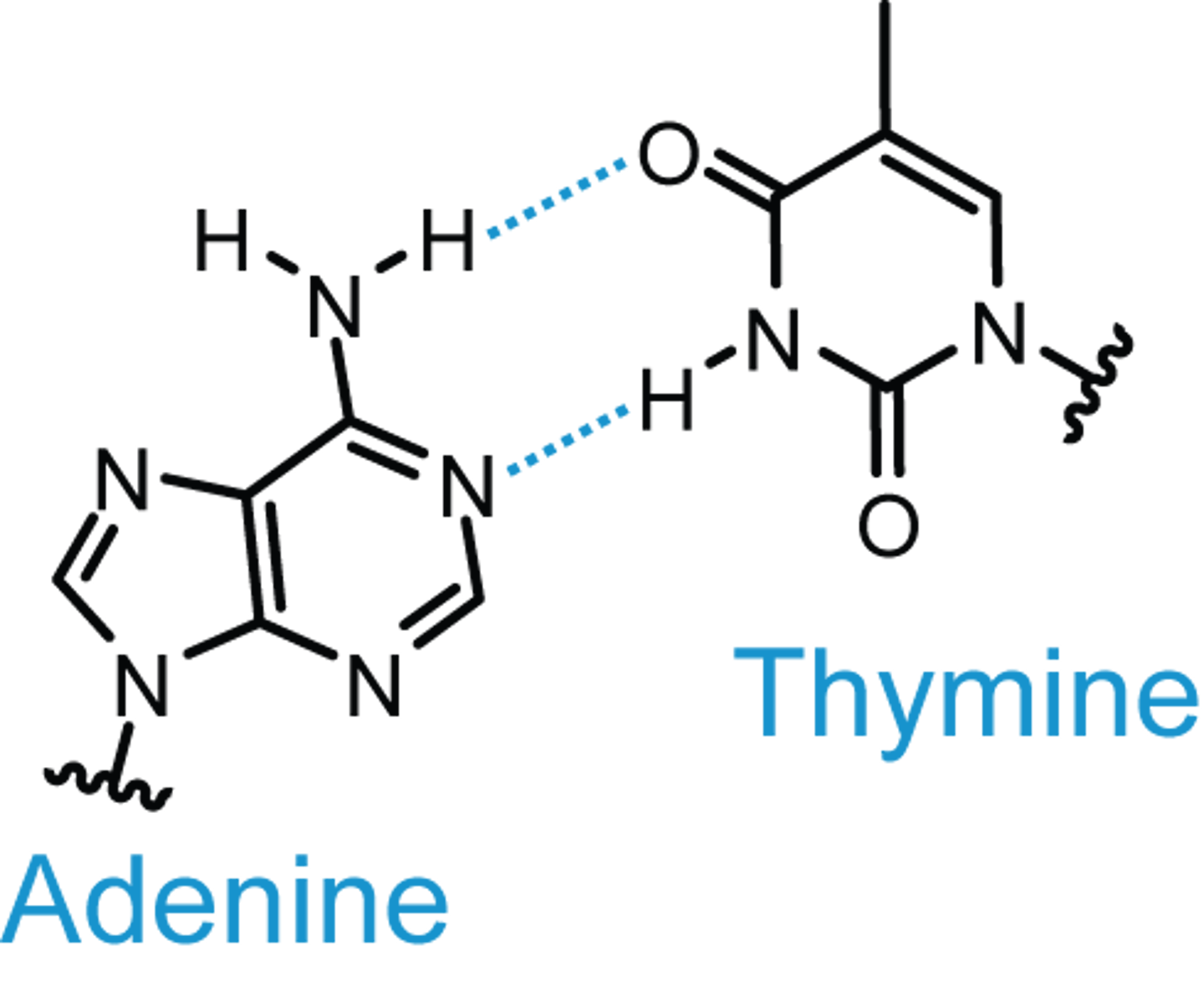
State the importance of complementary base pairing
necessary for replication
Explain how the properties of water allow water striders(organisims) to inhabit the surface of water
- cohesion as a result of hydrogen bonding between water molecules
- cohesion responsible for surface tension
Outline the properties that make water a universal solvent
- its ability of water to dissolve hydrophilic molecules
- can dissolve a lot things
- water is a medium for metabolism
Explain the factors that contribute to the stability of the DNA double helix.
- complementary base pairing because it forms hydrogen bonds that hold the two strands together
- equal bond length for purine & pyrimidine base pair - ensuring a consistent structure within the DNA helix
Describe the structure of a nucleosome
- DNA wrapped around 8 histone proteins
- held together by an additional histone protein attached to linker DNA
Outline the Hershey-Chase experiment
- growing bacteriophages in the presence of radioactive isotopes, either phosphorus-32 or sulfur-35 , then allowing these labeled phages to infect bacteria; by separating the phage from the bacteria after infection, they demonstrated that the radioactive phosphorus (DNA) entered the bacterial cell, confirming DNA as the genetic material Not protein
(i) Identify a component of RNA nucleotides which is not found in DNA nucleotides.
(ii) Outline the structure of a DNA molecule.
- uracil
- double stranded
- adenine - thymine AND guanine to cytosine
- sugar phosphate backbone
(i) Distinguish between adhesion and cohesion.
(ii) State the type of bond responsible for water's adhesive and cohesive properties.
- adhesion as the attraction between water molecules and other (often polar) substances
- cohesion as the attraction between water molecules
- hydrogen bonds
State how water is hypothesised to have originated on Earth
asteroids
Define anabolism and give an example of an anabolic reaction in living organisms
anabolism - synthesis of complex molecules from simpler substances
- protein synthesis
Describe the term polar molecule.
- part of the molecule has a slight positive charge, part has a slight negative charge
- unequal sharing of electrons in covalent bonds
Suggest examples of two biologically significant properties of water that depend upon the polar nature of water molecules.
cohesion
- water molecules adhere to each other
- column of water rises in the xylem in the transpiration stream
adhesion
- water molecules adhere to other (charged) molecules
- adheres to xylem walls of plant cells causing the layer of moisture
Describe what happens to a water molecule during an anabolic reaction.
water molecule is incorporated into the molecule/used up
(not exact image) State the form of the viral reproduction shown. Justify your answer
- Lytic cycle
- host cell is destroyed
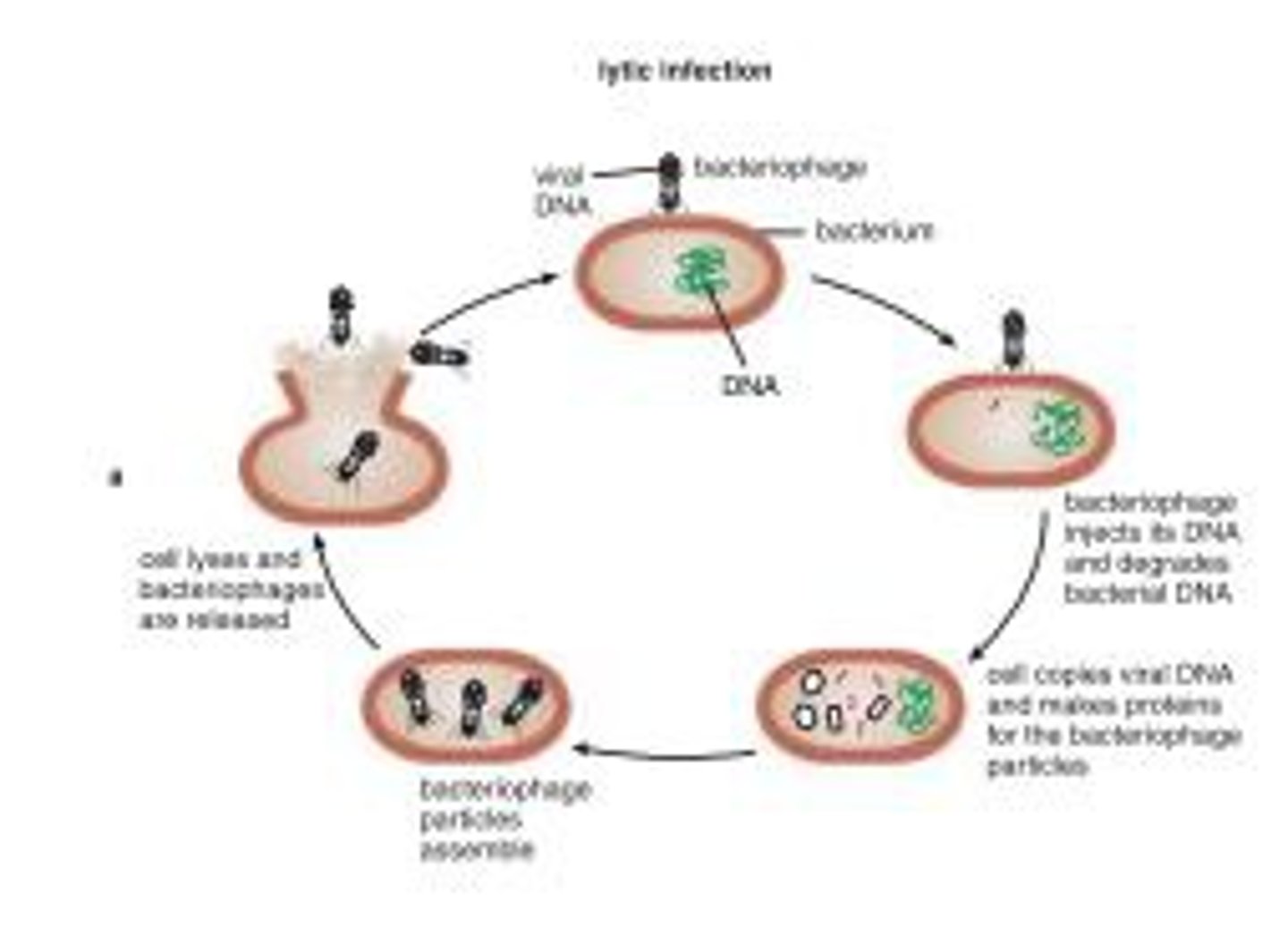
Compare and contrast the structure of viruses
-Similar : no cytoplasm, small size
- Difference :genetic material can be DNA or RNA
- Identify the type of cell shown. Justify your answer
- State a structure, not already visible, that you would expect to see if the magnification of the electron microscope used was increased
- Identify a visible feature of this cell which could provide evidence for the endosymbiotic theory
- plant cell
- ribosome(dosent matter if not on there )) not real image
- chloroplast, mitochondria
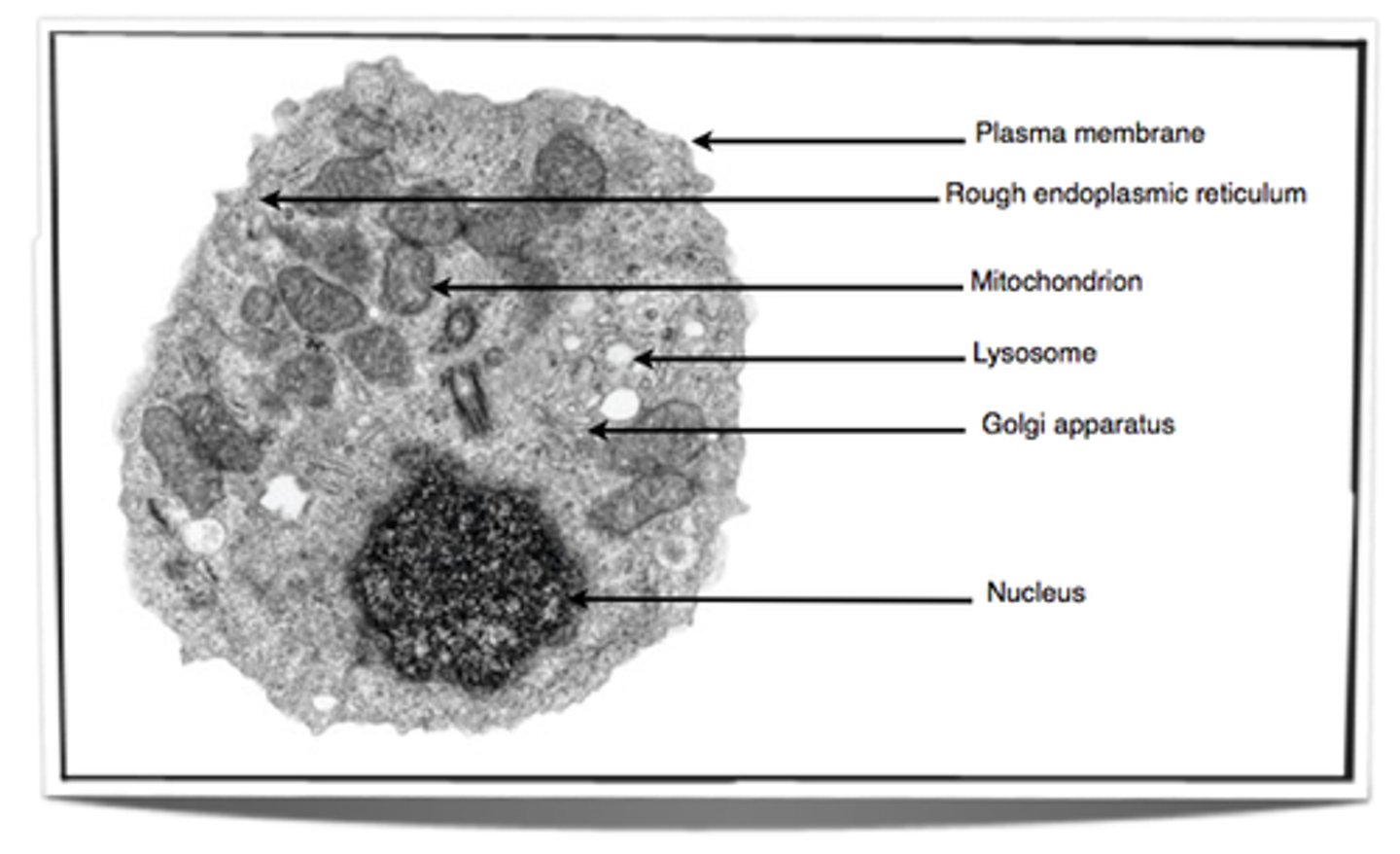
Distinguish between the lytic and lysogenic cycle of a virus.
- host cell is destroyed in the lytic cycle BUT not in the lysogenic cycle
- viral genome is incorporated into the host genome in the lysogenic cycle BUT not the lytic cycle
State two features common to all viruses
- capsid made of protein
- cytoplasm absent
Describe the origins of the first eukaryotic cells
- eukaryotic cells evolved from one common ancestor WHICH had a nucleus and reproduced sexually
- endosymbiosis as the process by which free-living prokaryotes were engulfed by eukaryotic and formed a symbiotic relationship
- endosymbiosis as the origin of mitochondria/chloroplast in (some) eukaryotic cells
State two processes of life that the first unicellular eukaryotic cells would have been capable of
- metabolism
- respiration
Outline the advantages of multicellularity in eukaryotic organisms
- increased body size
- increased storage
State an advantage to using electron microscopy compared to light microscopy
- higher resolution
Compare and contrast prokaryotic and eukaryotic cell structure
- BOTH have cytoplasm
- eukaryotic cells have DNA associated with proteins HOWEVER prokaryotic cells have naked DNA
- eukaryotic DNA is linear BUT circular in prokaryotes
Describe the conditions of early Earth
- lack of oxygen
- higher concentrations of carbon dioxide
List the necessary requirements for the evolution of the first cells
- self-replication of molecules
- self-assembly
- emergence of compartmentalisation
Explain why RNA is thought to have been the first genetic material.
- RNA can be replicated
- RNA has catalytic activity
Describe the advantages of developments in microscopy techniques
- electron microscopy produces high resolution images
- freeze fracture allows planar views
-cryogenic electron microscopy to determine the 3-dimensional structure of a molecule
- fluorescent stains can enhance the visualisation of cells and/or structures
Outline the features common to all viruses
- all viruses are small OR have a fixed size
- all viruses contain genetic material
- all viruses have a capsid
- all viruses lack cytoplasm
Compare and contrast different cell structures (plant, animal, fungak)
Similarities
- compartmentalised cytoplasm
- nucleus possesses a double membrane with pores
- plasma membrane
- 80s ribosomes
differences
- vacuoles are BIGGER in plant cells compared to animal cells
- plant cells can contain chloroplast BUT animal cells and fungi OR other eukaryotes do not
- centrioles are found in all animal cells BUT not all plant OR fungal cell
Describe the endosymbiotic theory of the origin of eukaryotic cells
-mitochondria/chloroplasts were once free living (prokaryotes
- larger eukaryotic cells had no organelles for respiration/photosynthesis
- became an integral part / organelle of the eukaryotic cell
- in a mutualistic relationship,
photosynthesised relationship described as prokaryote providing energy and larger cell providing nutrients ✓
Micrograph Chlamydomonas (unicelluar organsim)
Draw a diagram of Chlamydomonas and label two features which are common to all eukaryotic cells
nucleus ✓
mitochondrion ✓
draw the image youself
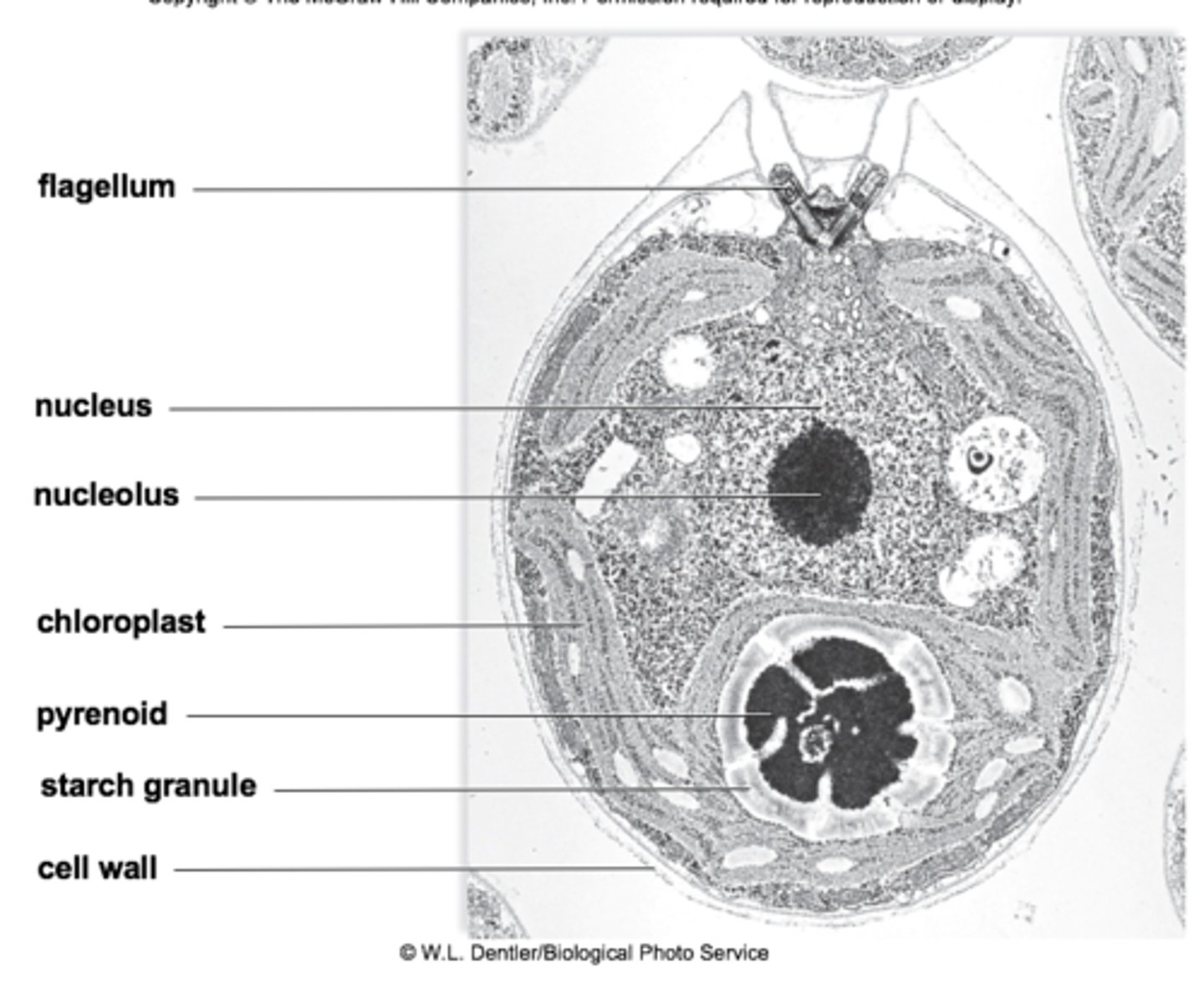
Identify a feature you would not expect to find in a unicellular organism like Chlamydomonas.
nucleoid
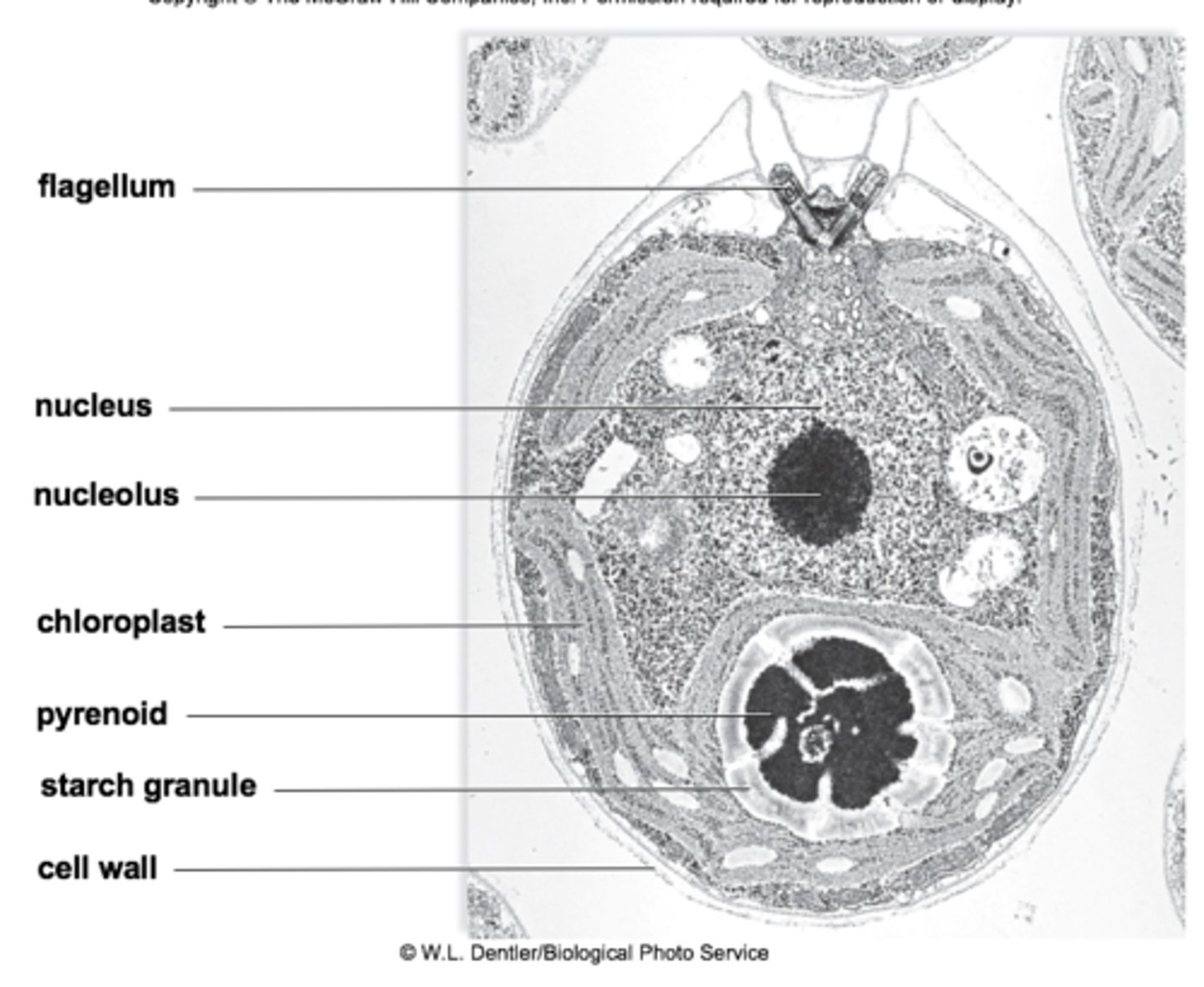
Suggest the form of microscopy that was used to produce the micrograph. Justify your answer.
electron microscopy
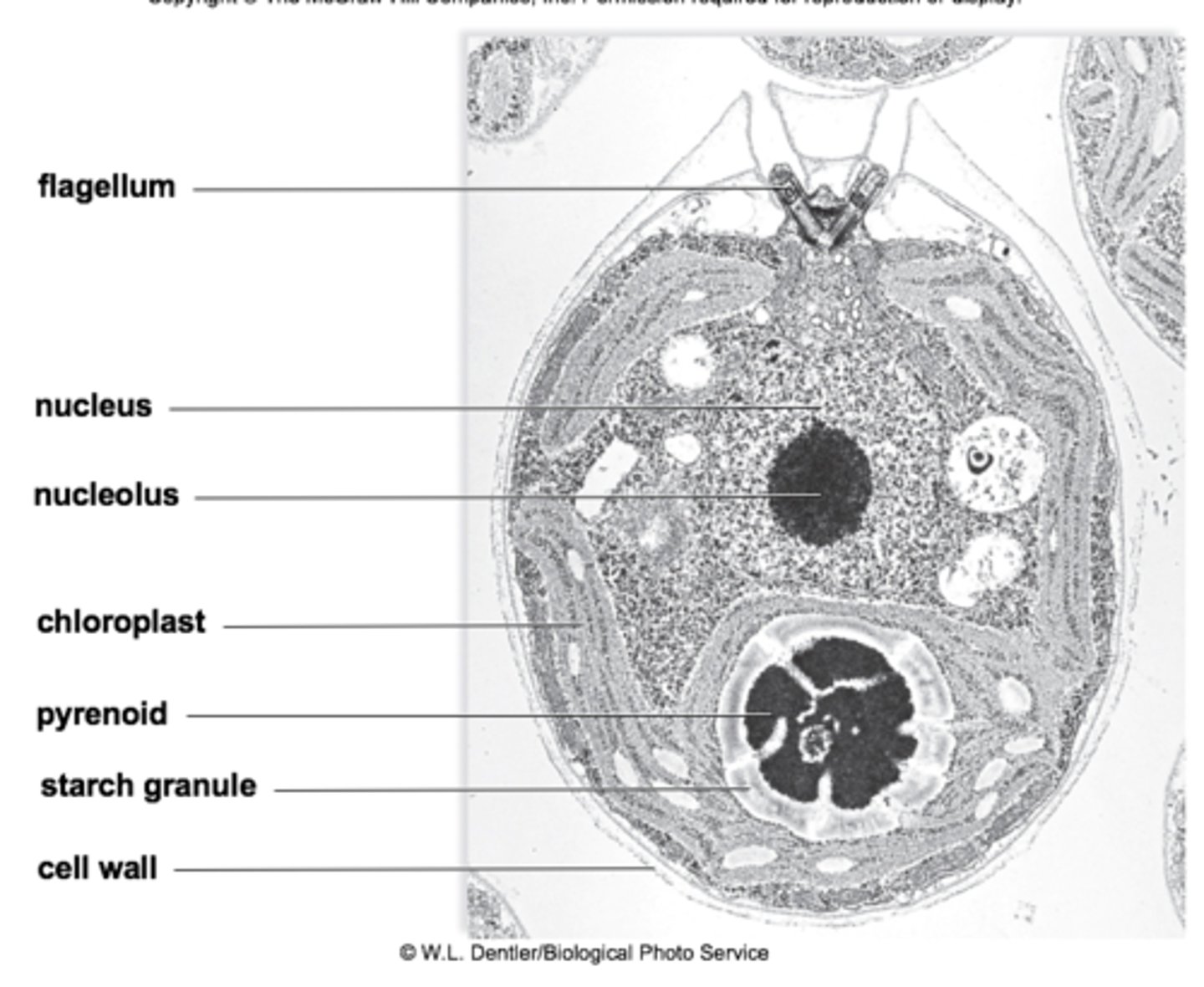
Four adult male Leopard geckos (Eublepharis macularius) would be shown
(i) State the name of the species to which the geckos belong.
According to the biological species concept, define a species.
- macularius
- a group of organisms capable of interbreeding to produce fertile offspring
(i) Describe how scientists could test if these geckos(Eublepharis macularius )belonged to the same interbreeding population.
(ii)Suggest an appropriate hypothesis and alternative hypothesis for this experiment.
- amino acid sequencing
- geckos belong to the same interbreeding population (hypothesis)
- geckos do not belong to the same interbreeding hypothesis (alternative hypothesis)
Describe a way in which the mixing of alleles between different species of Gecko(Eublepharis macularius ) may be prevented.
geographic isolation
- State a form of evidence which is commonly used to construct cladograms.
- Define the term clade.
- amino acid sequence of proteins
- a group of organisms which share a common ancestor
Describe the structure of cladogram.
- root as the initial ancestor common to all organisms in the cladogram
- node as a common ancestor shared between two or more organisms in a cladogram
- terminal branch as representing a species within the cladogram ✓
(i) State a way in which the genome within a species can vary.
(ii) Describe the current and one future application of genome sequencing.
- base sequence of DNA can vary
- constructing cladograms
- molecule clocks
Define the biological species concept.
a species is a group of organisms that can interbreed to produce fertile offspring
Describe the impact of adaptive radiation and hybridization on biodiversity
-adaptive radiation as the process by which members of a species diverge rapidly to occupy available niches (increasing biodiversity)
- hybrids as a result of interbreeding between two different species
- hybridization can increase diversity BECAUSE it can lead to the formation of a new species (if fertile
- adaptive radiation as a source of biodiversity BECAUSE it leads to the evolution of new species from an ancestral species
Describe the structure of a cladogram
- root as the initial ancestor common to all organisms in the cladogram
- node as a representation of a common ancestor between two organisms
- terminal branch corresponds to a specific species in a cladogram
- clade as a group of organisms which evolved from a common ancestor
Discuss the current biodiversity crisis
overhunting
overexploitation
urbanisation
deforestation
habitat loss
pollution
invasive species
loss of mixed dipterocarp forest in Southeast Asia as an example of ecosystem loss
Distinguish between a karyogram and a karyotype
Karyogram - image/photograph (of chromosomes);
Karyotype - property of the individual's chromosomes/number and types of chromosomes present in the nucleus/diagnosis derived from chromosomes
Outline how studies of DNA structure can be used to construct cladograms
scientists compare the DNA sequences of different organisms, identifying shared mutations or similarities to infer evolutionary relationships, where organisms with more similar DNA sequences are considered more closely related and are grouped closer together on the cladogram.
Compare and contrast allopatric and sympatric speciation.
BOTH involve an isolation barrier
allopatric speciation involves geographic isolation BUT sympatric does not
(i) State the term used to describe the mechanism behind speciation.
[
(ii) Describe the impact (i) has on biodiversity.
- adaptive radiation
- increases biodiversity
(i) Define the term evolution.
(ii) State two sources of evidence for evolution.
evolution as the change in heritable characteristics of a population over time
- base sequences of DNA OR RNA
- amino acid sequences of proteins
Distinguish between homologous and analogous structures.
homologous structures are a result of common ancestry BUT analogous structures are a result of convergent evolution ✓
Outline the process of speciation.
a single population splits into two or more distinct species, typically occurring when a population becomes geographically isolated, leading to genetic divergence and eventually reproductive isolation, preventing individuals from the different populations from interbreeding and creating new species.
bonobos and common chimpanzees
Distinguish between the evolution of analogous and homologous structures.
- analogous structures as similar in function but not a result of common ancestry OR as a result of convergent evolution
- example of analogous structure e.g. dolphin and shark fin
- homologous structures as similar features as a result of common ancestry
- example of homologous structure e.g. pentadactyl limb
Discuss the challenges associated with defining a 'species
boundaries between populations can be blurry, with factors like hybridization, asexual reproduction, and cryptic species making it difficult to apply a single, universally applicable definition
Outline speciation.
the evolutionary process where a single ancestral species splits into two or more distinct species, occurring when populations become reproductively isolated from each other, leading to genetic divergence and the inability to interbreed, thus creating new species over time
bonobos and common chimpanzees
Explain, with a reason, whether these images represent analogous or homologous structures.
homologous;
similar structure, different function/same evolutionary origin; ✓
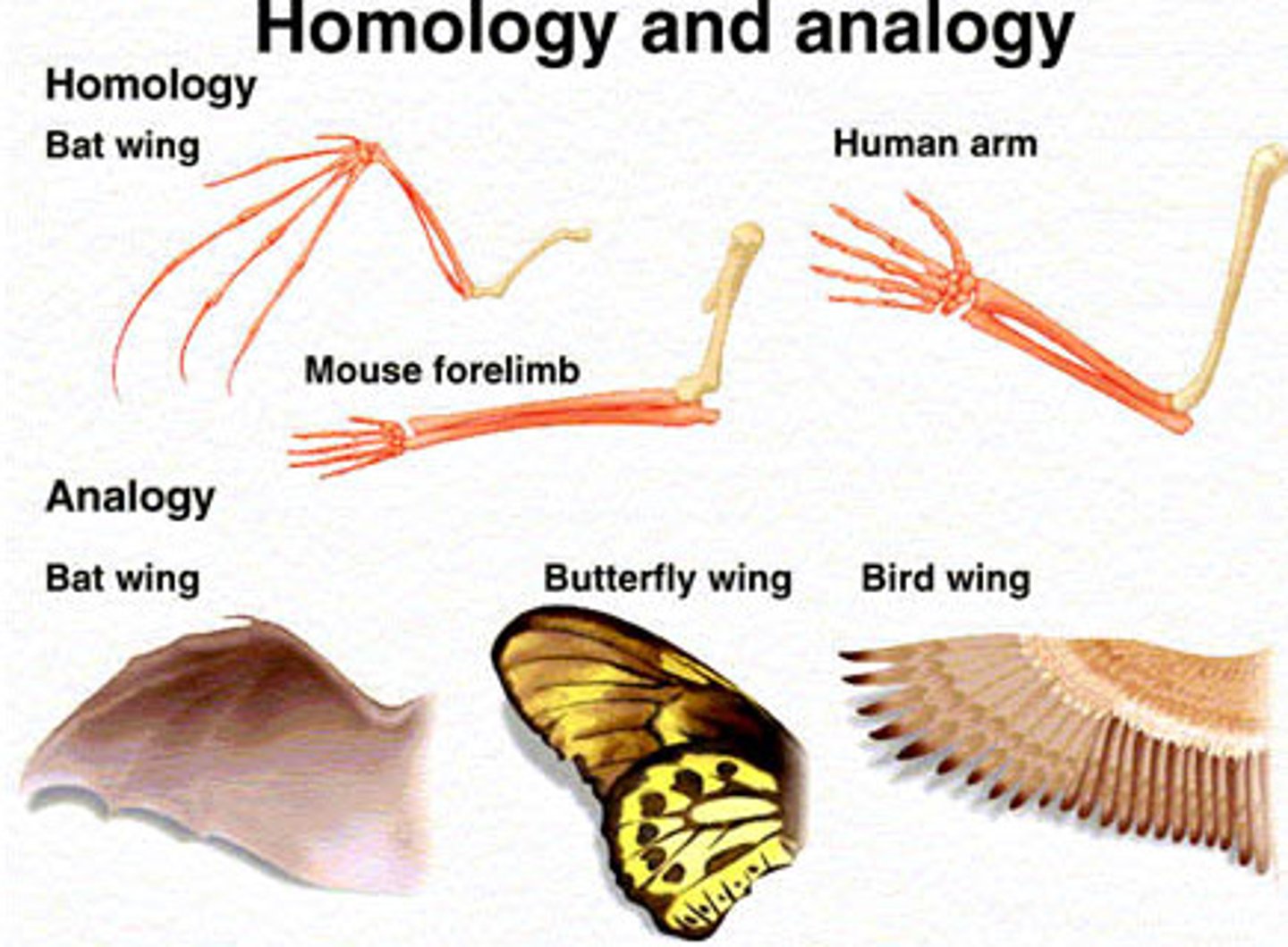
Comment on the relative lengths of the humerus (A in figure) between a human and a dolphin to the size of the whole limb. (just use whale
human is 40%/close to half the length of the limb;
dolphin is 15%/ less than one quarter; ✓
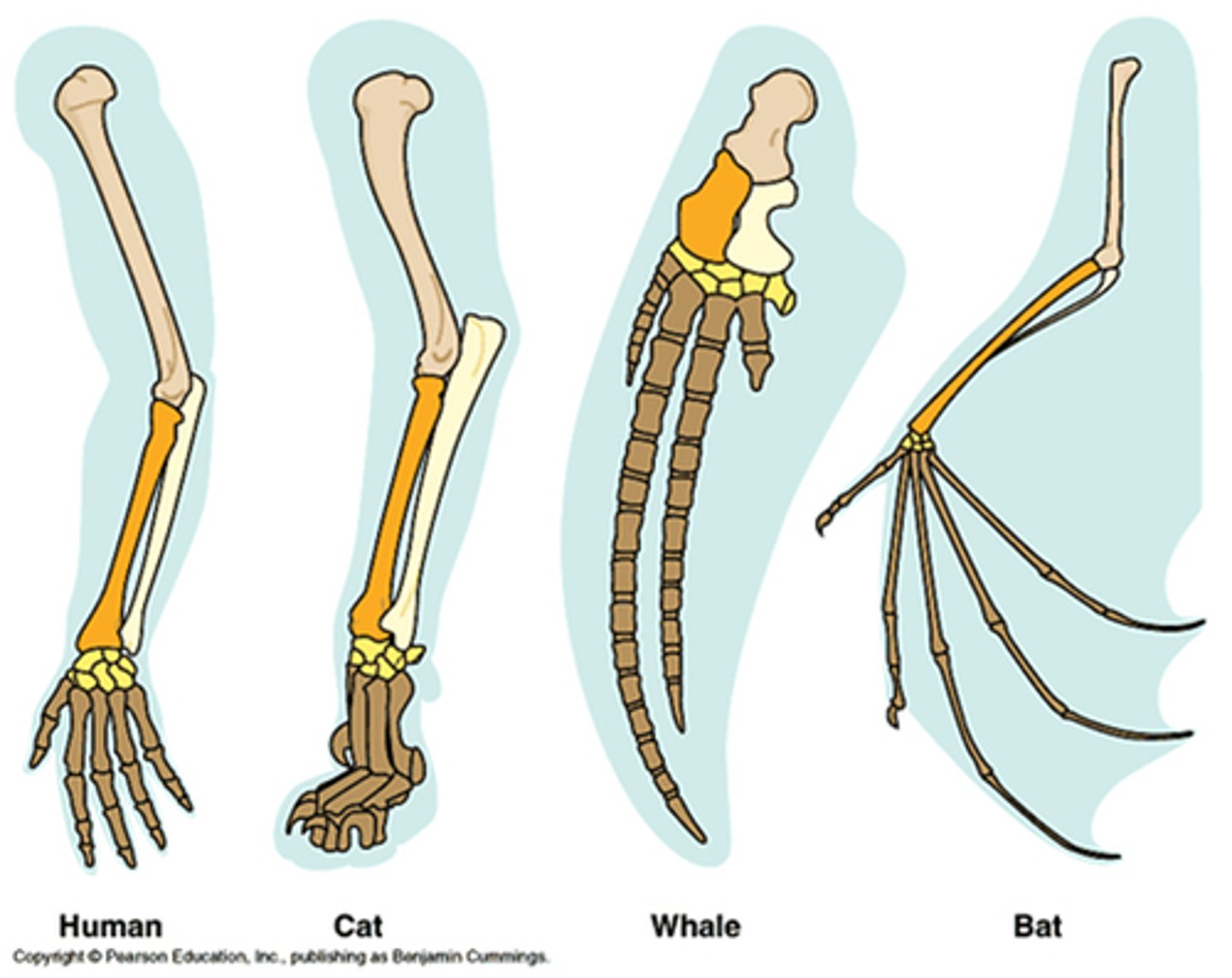
Compare and contrast the structure of the metacarpals (shown as B and C) of a bat and a horse and relate this to their role in movement.
- horse one metacarpal
- bat has five
- horse metacarpal less than half limb length;
-bat metacarpal half more than half limb length;
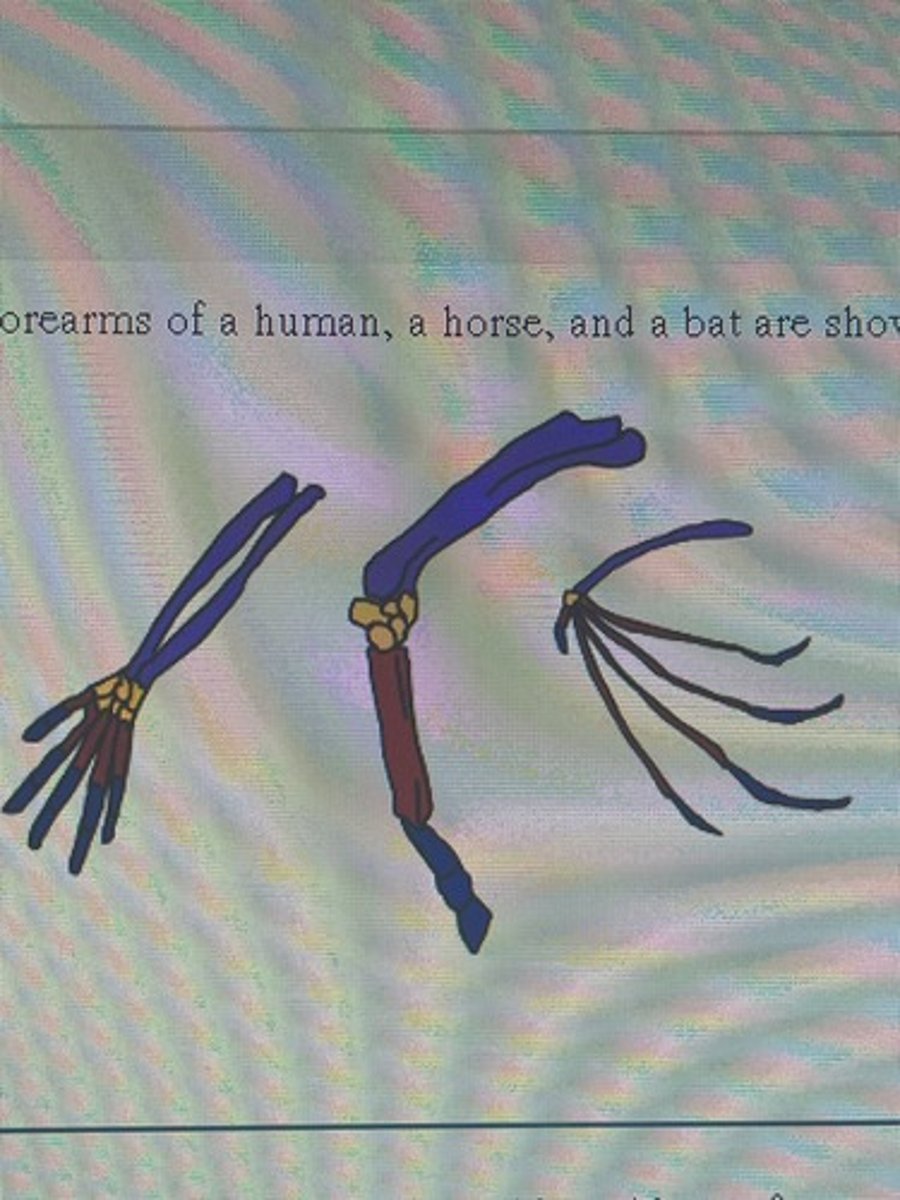
Outline the meaning of adaptive radiation using the pentadactyl limb as an example.
- adaptive radiation - evolution from the same origin for a different function/followed by speciation for a different function
- similar bone structure/pentadactyl structure
- adapted to varied means of locomotion (USE AN EXAMPLE)
Evaluate the extent that such structures provide evidence for evolution.
likely that very similar structures developed from a common ancestor/selected from one ancestor as an adaptation to movement/unlikely to be so similar if not evolved from a common ancestor do not show mechanism of evolution.
Describe the levels of protein structure using haemoglobin as an example
primary structure is the sequence of amino acids;
- joined by peptide bonds
- linear structure
secondary structure is the folding of the amino acid chains;
- by hydrogen bonding/other bonds ✓
- a helixb pleated sheet
tertiary structure is folding (of the secondary)
- into a 3-dimensional shape
- intertwining of the chain
quaternary is the assembly of subunits - polypeptides)
- 4 chainsnon-protein components of molecule
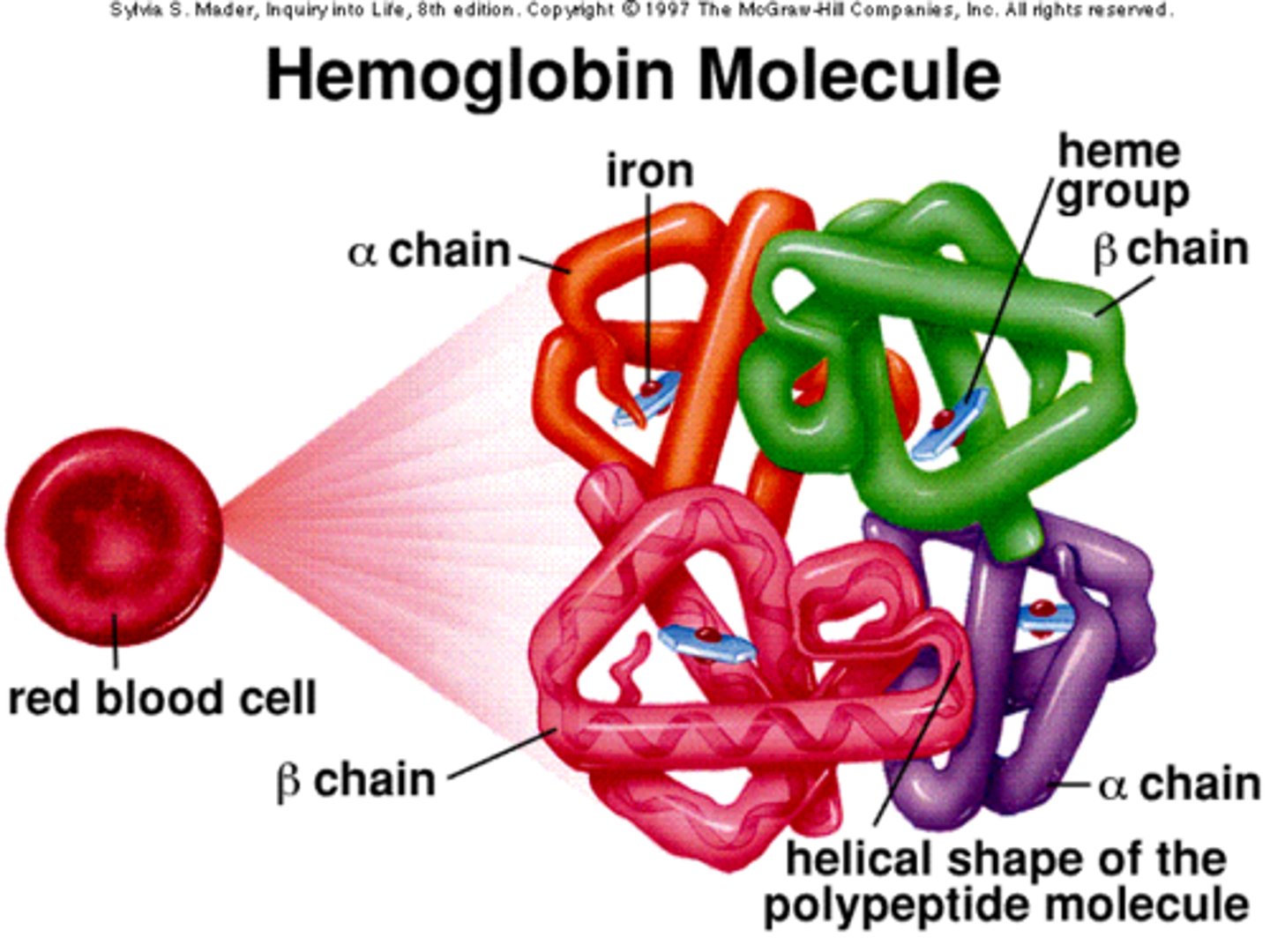
Deduce the required information for the molecular structures listed in the table
Generic (general) name of type of molecule
Polymer that can be assembled from this molecule
CH3(CH2)14COOH -
H2NCH(CH3)COOH
C6H12O6
- fatty acid ✓ (saturated)
- lipid or fat ✓
- amino acid ✓
- protein ✓
-sugar ✓
- starch✓
Draw a diagram of the structure of DNA labelling the molecules which make up the backbone.
label the backbone
